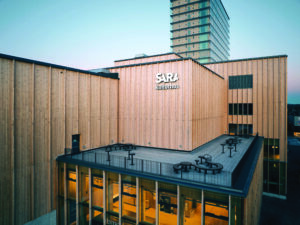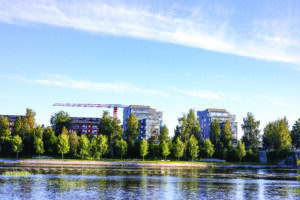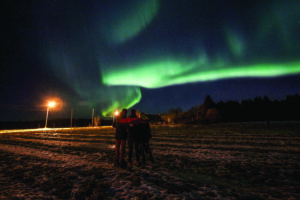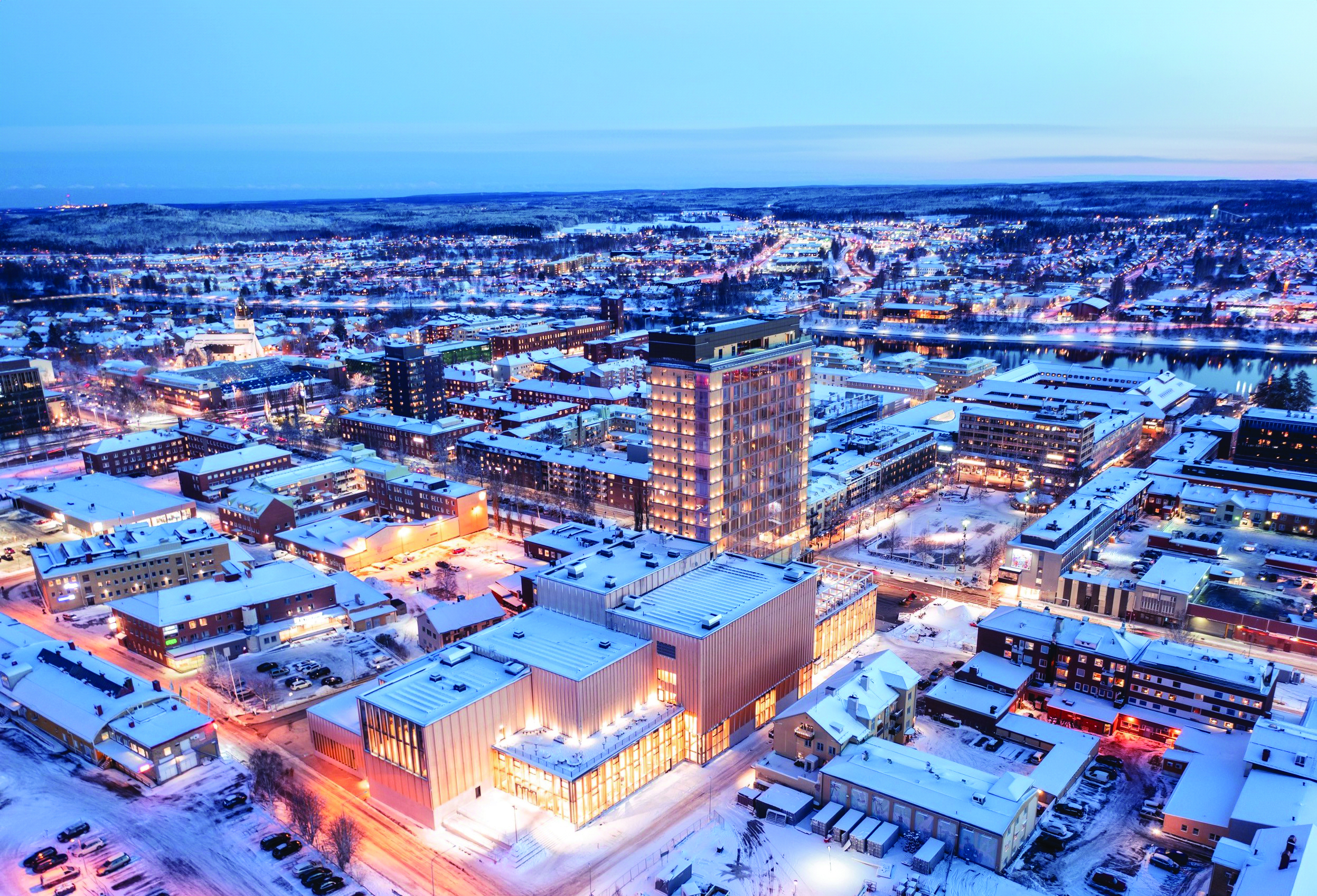

By Hanna Holländer, CEO and Research Director
Sofia Molin, Senior Research Manager
Beyond Research
Stockholm, Sweden
hanna@beyondresearch.se
sofia@beyondresearch.se
In THE NORTH OF SWEDEN, catching a glimpse of the sun in winter is somewhat of a pastime for many. From the time you wake up to the time you go to bed, you spend most of the day under a “night” sky—the small glimpse of the sun that shows itself around lunch becomes very important. This pastime of spotting the sun is a game that many Swedes spend the bigger part of their year practicing because, most months, we are in the dark.
bigger part of their year practicing because, most months, we are in the dark.
Despite this, last year, over 2,000 people decided to relocate to the small, northeastern Swedish city of Skellefteå, making it one of the most popular cities to move to in Sweden. How does a city without a train station, located 20 miles south of the Arctic Circle, with more darkness than sunlight, become the hottest spot in Sweden to move to? What role did qualitative research play in making this happen? It started with the city commissioning qualitative research to address a skills shortage, recognizing the competition for workers and a shift among young people that reprioritizes a rural lifestyle, and ended with the award-winning creative campaign, “Sorry Sweden.”
Historic Social Transformation and New Green Industries in Sweden
Like almost all rural parts of Sweden, the town of Skellefteå has been facing a decrease in population for the past 20 years. The impoverishment of rural areas in Sweden has steadily increased as people have been leaving the countryside for the big cities.
 But in the last couple of years, we have seen a change. The people of Sweden are creating a new green wave by giving up life in the big city in favor of smaller towns and more rural areas, where life is simpler, and you can get a large house for the same cost as a tiny studio apartment in the capital city of Stockholm.
But in the last couple of years, we have seen a change. The people of Sweden are creating a new green wave by giving up life in the big city in favor of smaller towns and more rural areas, where life is simpler, and you can get a large house for the same cost as a tiny studio apartment in the capital city of Stockholm.
The pandemic has, in many ways, sped up the process and changed what people value regarding work/life balance. Studies, such as Workmonitor 2024, where 27,000 employees all over the world have given their perspective on work life, show that new priorities are emerging as people today tend to prioritize their personal lives over careers. They also value flexibility and the possibility of working from home—which has become a nonnegotiable for many.
At the same time, Sweden is undergoing a historic social transformation with the establishment of several green industries that aim to contribute to a fossil-free society. This access to green energy is crucial for industries that want to reduce their carbon footprint. One of the main reasons many green industries establish themselves in the north of Sweden is because of the access to renewable energy from sources such as hydroelectricity and wind farms.
several green industries that aim to contribute to a fossil-free society. This access to green energy is crucial for industries that want to reduce their carbon footprint. One of the main reasons many green industries establish themselves in the north of Sweden is because of the access to renewable energy from sources such as hydroelectricity and wind farms.
LKAB, Northvolt, and H2 Green Steel are making huge investments in the northern parts of Sweden, which is estimated to lead to 100,000 new job opportunities in 200 different professions in the region.
The Global Skills Shortage
One of the major challenges for the large green industrial establishments in Sweden is the inadequate supply of skilled workers; companies must, therefore, seek employees outside the county and even outside the country.
 This is not only true for Sweden. Employers around the world are sounding the alarm about a quickly growing skills shortage in all industries, from IT to healthcare. Globally, 77 percent of employers face difficulties in recruiting the right skills, a record high; just five years ago, in 2018, the skills shortage was 45 percent, according to ManpowerGroup’s Talent Shortage survey, which is based on interviews with more than 40,000 employers in 40 countries. The battle for talent is intensifying.
This is not only true for Sweden. Employers around the world are sounding the alarm about a quickly growing skills shortage in all industries, from IT to healthcare. Globally, 77 percent of employers face difficulties in recruiting the right skills, a record high; just five years ago, in 2018, the skills shortage was 45 percent, according to ManpowerGroup’s Talent Shortage survey, which is based on interviews with more than 40,000 employers in 40 countries. The battle for talent is intensifying.
To meet the growing need of skills supply, government districts and private companies need to utilize innovative strategies to attract employees with the right skill sets, attracting talent both nationally and internationally. Therefore, “place branding” and “target group adapted communication” is becoming increasingly important. Place branding refers to the marketing of cities, regions, and countries. Just as companies use branding for their products, places can also use branding as a way of highlighting what makes it appealing and memorable. A goal of creating a unique identity through place branding can be to attract new residents and tourists to the area.
Qualitative Research as a Base for a Communications Campaign and Place Branding
With the establishment of the Northvolt factory in Skellefteå, the city is forced to grow quickly and sustainably. It also needs to attract talent from all fields, from industry jobs to healthcare and schools. To reach the new population target by 2030, Skellefteå must double the number of people moving in each year. This is where qualitative research came into the picture.
On behalf of the municipality of Skellefteå and its communications agency, Beyond Research conducted a qualitative study with the goal of creating a communications campaign. The aim of the campaign was to increase the number of people who have Skellefteå on their shortlist of cities they would consider moving to, influence the evaluation phase so that more people choose Skellefteå when evaluating their options, and increase the rate of migration for those who are already considering moving to Skellefteå.
More specifically, the objectives of the study were to establish the image of Skellefteå, find triggers and driving forces, as well as concerns and obstacles for moving to Skellefteå. Furthermore, we wanted to get a deep understanding of what Skellefteå needs to do to become the optimal city to live and work in the future, and how to communicate this to potential newcomers.
For the study, we did a combination of online focus groups (four groups of six = 24 total) and in-depth interviews (18 total).
- For the focus groups, we spoke with two target audiences: 1) people who were open to moving to a smaller or mid- sized city in general, and 2) people who wanted to move to Skellefteå specifically.
- For the in-depth interviews, we spoke to people born and raised in Skellefteå, who have lived a few years in a different city for studies and/or work, but who have recently moved back to Skellefteå.
As part of Beyond Research’s efforts to maintain high quality throughout the project, the recruitment of participants was conducted in-house, partly through a collaboration with the municipality using access to their social media channels, and partly through our own ads on social media (Instagram and Facebook). Participants were screened via a short initial interview to ensure they fit into the different target groups and were articulate and creative.
One key activity in our discussion guide to capture emotional drivers was an exercise where participants were presented with some 50 adjectives, both positive and correspondingly negative, and were asked to choose three adjectives that best described their feeling of Skellefteå today and optimally in the future. The exercise showed that in addition to positive values, such as down-to-earth, innovative, and sustainable, there were also several negative values that characterized the image of Skellefteå. One negative value that was raised was that Skellefteå feels closed, relative to fear of resistance and difficulty in being welcomed into the community as a newcomer. In addition, prejudices about Skellefteå as an old-fashioned and slow city were also mentioned. Thus, the exercise provided direction and key ideas for the desired development of Skellefteå in general and in future communications.
Creating Opportunities for an Active Social Life and Social Contexts Is Essential
One key finding of the study was that housing is usually the first concrete step in the move; it often comes before the job search—many start their new lives by working remotely and/or during parental leave. In Sweden, parental leave is quite generous compared to other countries; parents have the opportunity to have governmental paid leave of up to 480 days.
Another important insight from the study regarded the importance of an active social life; often, potential movers worry they will find themselves without a fulfilling social life and a supportive community with which they resonate. To counteract these fears, we recommended that the city broadcast the many ways to become part of the city’s culture that convey Skellefteå as a vibrant, open, welcoming city with many opportunities for fun and social engagement.
Another important target group was the co-movers (the partner who is less active in the process of moving and who doesn’t have family or work there). We advised the city to message this co-mover group specifically, as they are often the key factor in whether the move is long-term or not, as they need extra support in finding their own social life. Creating opportunities for social contexts is essential.
Actionable Insights
The communications agency Kid Collective created several actions based on the results of the study.
- Skellefteå’s new campaign, “Sorry Sweden,” has over 45 million views and made it to the finals at “Placebrander of the Year 2024” in the category Municipalities, Regions, and Destinations (the winner is not yet announced).
- An activity guide to help people find attractive activities and get integrated into the social scene is particularly important for the target group of co-movers, as it provides opportunities for them to find their own social contexts and meet new friends that increase the chances of wanting to stay in the future.
- A move-in service offers people personal assistance by email or phone for any and all of their questions regarding how the housing market works, everything from building a new house to finding a moving service, getting information on how to find a rental, and more.
- A newcomers’ guide to Skelleftea includes information regarding everything from how to find a preschool, nice areas to walk your dog, information about government agencies, and much more.
Skellefteå’s Population at an All-Time High
Today, we can see—with excitement and content—that Skellefteå’s investment in research and messaging has paid off. The small northern town, once known for its darkness and chilling temperatures, has experienced the largest population increase in over 50 years, two years in a row!
However, with the record-high migration also comes high demands for public services, infrastructure, and, last but not least, housing. To be able to meet the challenges of the housing shortage in Skellefteå, the town has been forced to resort to unconventional solutions. Northvolt has built Sweden’s largest modular village to house migrant workers—the size of nine soccer fields!1
Another creative way to ease the housing shortage, which several municipalities all over Sweden are trying, is bringing life back into old, abandoned houses. Restoring an abandoned house is a way to bring life to rural areas, as well as a sustainable option over building a new home. This is something that is seen in other parts of the world as well; there is even a word for the phenomenon in Japan, “akiya,” meaning empty house.
An Increase in Studies Regarding Talent Attraction
At Beyond Research, we have seen an increase in studies regarding talent attraction in the last few years, both from companies needing niche skills within IT and engineering, as well as rural communities looking to create “place attraction.” The case of Skellefteå is a great example of how qualitative research can play an important part in helping municipalities, cities, and companies identify drivers and barriers when taking action and creating target group-based communications.
Reference:
Berno Johnsson. “This is where the battery factory builders will live—Sweden’s largest modular village is being built in Skellefteå,” Sveriges Television, April 15, 2024. www.svt.se/nyheter/lokalt/vasterbotten/har-ska-batterifabriksbyggarna -bo-sveriges-storsta-modulby-byggs-i-skelleftea




